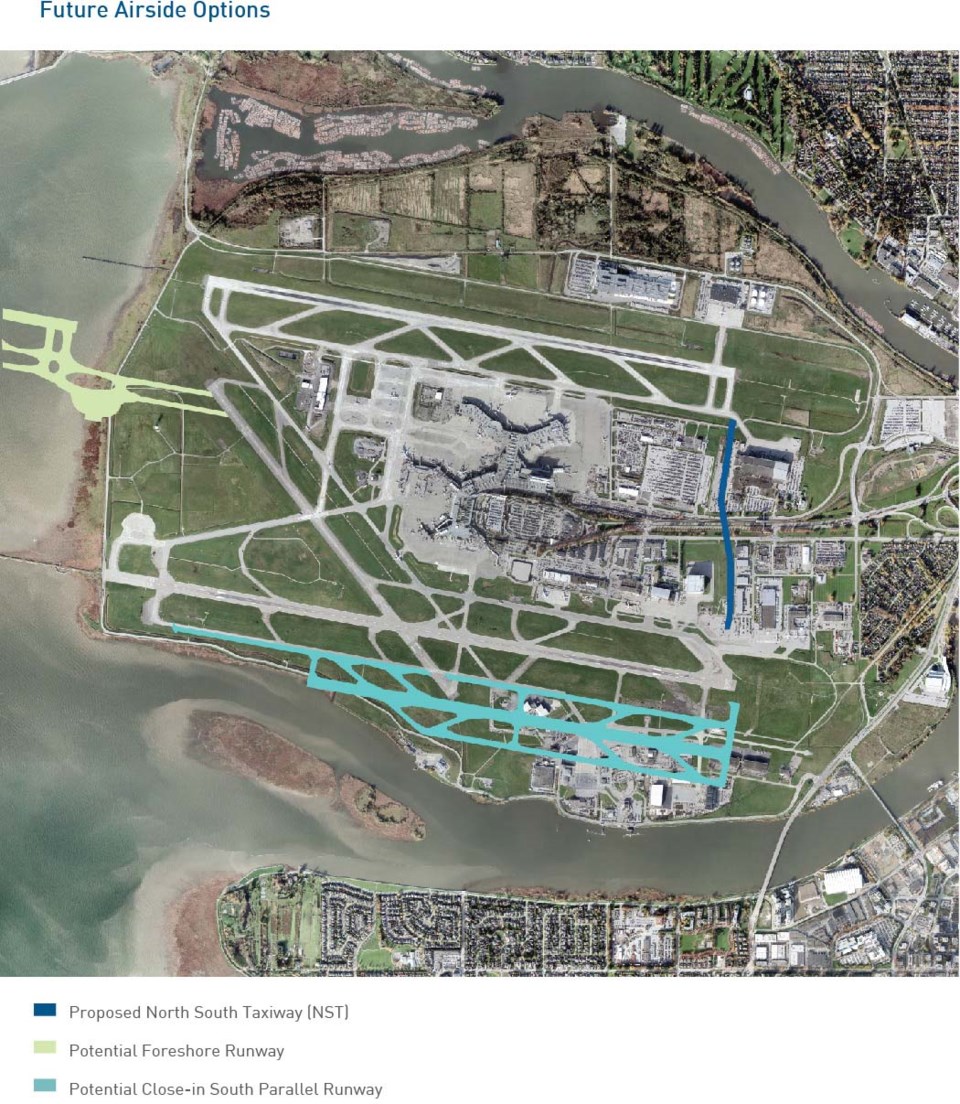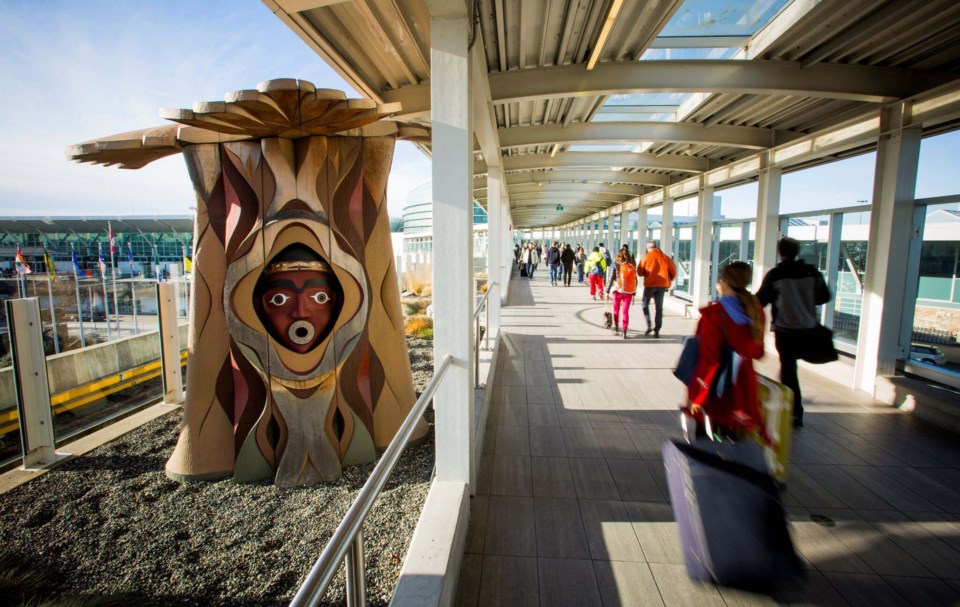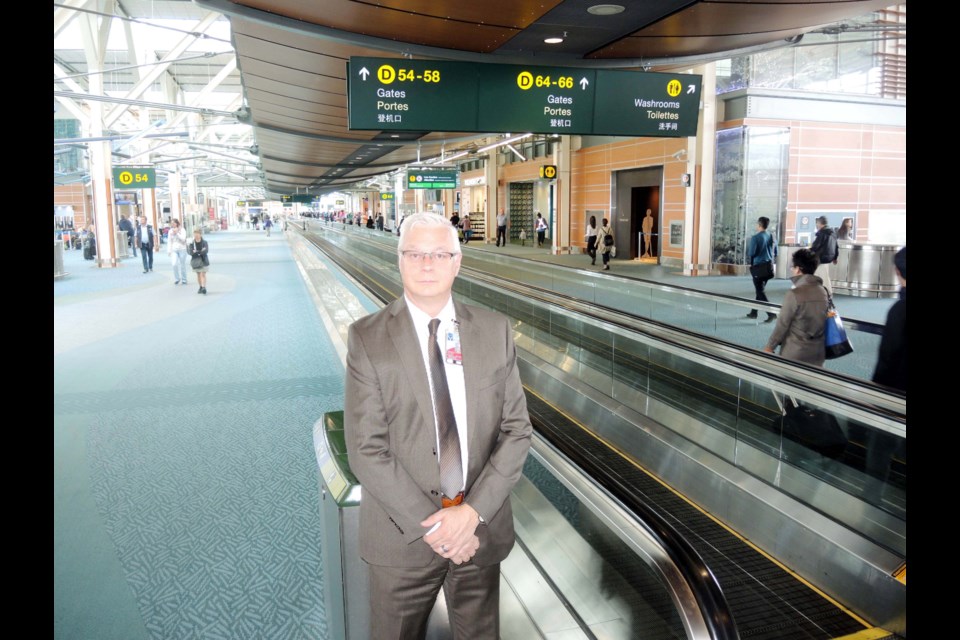Dozens of people were sitting on high stools, drinking coffee and glued to their phones, perhaps studying their travel plans for the 20th time in the last 10 minutes.
Scores of others had stopped, sat down their baggage and dug out their boarding passes, probably scanning and double-checking their gate times.
Hundreds simply stopped and stared, their attention arrested by the beauty of the now iconic Jade Canoe sculpture on the second floor of YVR’s international terminal building.
There was nothing special about this particular Monday.
Airport staff, pilots and crew were weaving in and out of the thousands of passengers, many of whom had their eyes either filling up with sorrow at leaving or brimming with excitement at jetting off on vacation somewhere around the globe.
It wasn’t a holiday, nor was it on the run-up to — or aftermath of — Christmas or Thanksgiving.
Yet, the terminal was buzzing, with throngs of men, women and children going about their business and adding to the ever-growing footfall at Vancouver International Airport — projected, by the end of this year, to hit around the 21.5 million mark, just 3.5 million shy of the terminal system capacity at YVR, which is expected to be reached and breached by 2020.
As we made our way through security and then strolled into “D-pier” in international departures, the rapid growth was not lost on YVR’s president and CEO Craig Richmond, who was discreetly surveying the faces of his customers, measuring their airport experience as we walked and talked all things YVR 2037 — the latest master plan currently in the works and massaging its way through the public consultation phase.
“Travelling is stressful and we do what we can to take that stress away, with lots of plants, carpets, visuals, public art,” said Richmond, as we paused for a moment and gazed down from above at the hordes of passengers negotiating their path through the customs hall.
“You may notice that there are very few announcements, it’s very deliberate. At some American airports, all you hear are gate announcements and security announcements.
“It’s just noise; we have announcements at the gates only. Otherwise, it just adds to the stress, it doesn’t penetrate.
“Me telling you not to leave your bag unattended, again and again; you don’t need to hear that.”
For the past 20 years, total passengers at YVR have increased at an average annual growth rate of 2.6 per cent, tempered only by significant global incidents, such as 9/11 and the international recession of 2009.
So it was no surprise to hear — as we ventured through duty-free and further into D-pier, via the moving walkway — there are plans ready and waiting for the international terminal to expand westward, adding four gates, with a view to adding another five down the road.
“Four gates doesn’t sound like a lot, but these are very big aircraft,” said Richmond.
“That’s why walking distances get so long in big international airports, because airplanes are so big.
“Through our walkways, we manage to keep the walking down to 1,000 feet. We do anticipate, as we grow, that more people will have limited mobility, more elderly people, so could have golf cart type transports that look like more like a train.”
Richmond said the airport has been planning the terminal expansions for the past year and half, with the hope of putting a spade in the ground sometime next year and a completion date of around 2021.
He did, however, caution against getting too greedy and rolling out everything envisaged in the master plan, which the airport is duty-bound to update every 10 years.
“You could get halfway through it and come across a global recession, so we like to do things incrementally,” said Richmond.
“What if the demand falls off? This way, we can put a hold on the growth or continue, depending on what’s happening.”
And even if the visions in the 2037 plan become reality — and the airport has to cope with the projected 35 million passengers by 2037 — where does it take YVR in terms of the global playing field?
“It’s not big on the world scale, not Heathrow, Amsterdam or Atlanta,” Richmond said.
“By the end of this plan, we could be at 35 million passengers; that is still a medium-sized airport, but with extremely good customer service and hopefully with people enjoying it, rather than enduring it.
“Toronto is at 40 million (passengers). When you get to 70, 80 and 90 million, those are the super-hubs.”
Until recently, YVR had been creating master plans with a 40-year projection into the future, before reeling that back to 20 years for the latest blueprint.
A completely new terminal building, independent of the current connected ones, is highly unlikely in Richmond’s tenure and beyond.
“There’s a technological limit, when you get to the end of 20 years, you start to get to the end of what’s knowable,” explained Richmond.
“We looked at 57 terminal designs for this plan and some designs just fell off. What we do look at is, can you transfer passengers easily?
“I personally hate getting into a taxi somewhere else in the world and getting asked ‘what terminal are you going to?’
“Keeping it all in the one terminal is important. We much prefer to do increments, where we can stop and start, off-ramps if you will, in case the economy falls.
“So instead of a big, new terminal out in the middle there, let’s just add to this one as long as we can.
“Eventually, without being facetious, someone’s granddaughter down the road might say, ‘Ok, it’s time to do what Heathrow has done and put a new terminal out there, because eventually we may run out of terminal space. But we’re talking decades down the line.”
No 3rd runway — in this generation at least

In YVR’s last master plan, formulated back in 2007, there were predictions of the need for a third runway in order to cope with demand.
However, in that time, technological advancements in aircraft has negated, in the near future at least, the need to seriously consider a third runway, something that has, down the years, caused considerable consternation within the local environmental community.
“In the last master plan, we did think, if this growth continues, we’re going to need another runway,” said Richmond.
“What happened was, in that time (last 10 years), the airlines started flying bigger and bigger airplanes, so we’re actually flying more people on fewer aircraft than we did back then; which is totally the sustainable way to go. And they’re much quieter.
“So it’s a huge relief for us that we don’t have to consider building another runway in the next decade or more.
“We may start studying it again in the next 15 to 20 years, we just don’t see the need for it right now.”
Richmond said the current parallel runway system, with more taxiways planned to make it more efficient, will suffice, at least for the lifespan of the master plan in the works.
“This year, we will have around 21 million passengers; Heathrow has two parallel runways and they’re at 70 million, so they need a new runway, but we’ve got a ways to go,” added Richmond.
Two options for a third runway are included in the 2037 master plan; one to the south and one, a “foreshore” runway, about 10,000 feet to the west, out onto the environmentally-sensitive Sturgeon Banks.
Should the airport ever seriously consider the foreshore option, Richmond said all kinds of environmental impact studies, outside the confines of any master plan, would be triggered.
“It’s something that our grandchildren will likely be working on,” he said, citing how far into the future such an expansion would even be needed.
“It would be a huge, extensive thing to do, so it would take years to study that.
“But if you talk to some people in Richmond, they’ll say ‘yea, put it out there,’ because it means less noise over Richmond. It would be quite a debate, but I’m pretty sure I will not be part of that debate.”
Environmental challenges
Heating and cooling what is likely the biggest building in the province — and set to expand under the 2037 plan — is no mean feat, let alone doing it in an environmentally-conscious manner.
“It’s absolutely what we think about. We could (heat and cool it) using solar panelled glass; we’re always thinking, ‘how could we build this with recycled materials?’
“In the past, all we would have is a business case, now we also have a sustainability case. What are we doing to positively move our sustainability numbers?
“We’re actually in the final stages of
designing a geothermal exchange plant onsite as part of this masterplan.”
Richmond also cited the fact the airport was the first in the world to achieve “Salmon Safe” certification, which is given to businesses that make efforts to deter pollutants from getting into the rivers.
Transportation will be key factor

With the number of passengers expected to use YVR projected to balloon by more than 50 per cent in the lifespan of the 2037 master plan, getting people to and from Sea Island will undoubtedly be a challenge.
That’s why Richmond is banking on continued improvements to the airport extension of the Canada Line over the next few years to facilitate that burgeoning passenger growth.
“Like anywhere in the Lower Mainland, (transportation is) such a big issue,” he said.
“The previous board members must get praise for spending $300 million on the Canada Line (extension), as we now have almost 20 per cent of the people that come to the airport, to work or fly, using the Canada Line.
“We want to get that to 30 per cent, so we have to talk to TransLink about adding extra trains and extra cars and looking at the designs of the platforms to drive more people onto the Canada Line; because it has a lot more capacity for us to use.
“We need the entire Lower Mainland to get a plan, but we’re not driving that, we’re consumers, not producers. But it is a huge issue for us, because it’s one — ground access — we don’t really have control over.”
As for extending the Canada Line further along the airport terminus, Richmond said that’s not in their mind.
“We do have room for another station, between the terminal and Sea Island station, if we needed to build the terminal out that far.”
The master plan will be submitted to the Minister of Transport in the fourth quarter of 2017 and should be finalized sometime in 2018.
Tell YVR what it should be doing
As part of phase two consultation for YVR 2037, until the end of October, you can go online to YVR2037.ca and complete their feedback survey.
Or, next Wednesday, Oct. 12, you can turn up at the YVR 2037 Open House and speak to the master plan project team, view the display boards and provide your feedback about the future of our airport.
The open house will be at the domestic terminal’s Observation Deck from 4 p.m. to 8 p.m. Pre-registration is not required.



